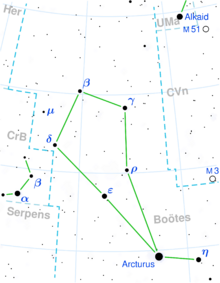Astronomy:Lambda Boötis
| Observation data Equinox J2000.0]] (ICRS) | |
|---|---|
| Constellation | Boötes |
| Right ascension | 14h 16m 23.01880s[1] |
| Declination | +46° 05′ 17.9005″[1] |
| Apparent magnitude (V) | +4.18[2] |
| Characteristics | |
| Spectral type | A0p λB[3] |
| U−B color index | +0.05[2] |
| B−V color index | +0.08[2] |
| Astrometry | |
| Radial velocity (Rv) | −7.9±1.6[4] km/s |
| Proper motion (μ) | RA: −187.33±0.14[1] mas/yr Dec.: 159.05±0.11[1] mas/yr |
| Parallax (π) | 32.94 ± 0.16[1] mas |
| Distance | 99.0 ± 0.5 ly (30.4 ± 0.1 pc) |
| Absolute magnitude (MV) | +1.71±0.23[5] |
| Details | |
| Mass | 1.66+0.19 −0.16[6] M☉ |
| Radius | 1.7[7] R☉ |
| Luminosity | 19.1+9.0 −6.1[6] L☉ |
| Surface gravity (log g) | 4.188[8] cgs |
| Temperature | 8720[9] K |
| Rotational velocity (v sin i) | 100[8] km/s |
| Age | 2.8+1.1 −0.8[6] Gyr |
| Other designations | |
| Database references | |
| SIMBAD | data |
Lambda Boötis (λ Boötis, abbreviated Lam Boo, λ Boo), also named Xuange[10] (/ˈʃwɛnɡə/[citation needed]), is a star in the northern constellation of Boötes. Based on parallax measurements, it is approximately 99 light-years from the Sun.[1]
Lambda Boötis is a white A-type main sequence dwarf with an apparent magnitude of +4.18. It is the prototype of a group of rare stars known as Lambda Boötis stars, all of which are dwarf stars with unusually low abundances of metals in their spectra. Its diameter has been directly measured to be 1.7 times that of the Sun.[7]
Nomenclature
λ Boötis (Latinised to Lambda Boötis) is the star's Bayer designation.
In Chinese astronomy, Lambda Boötis is called 玄戈, Pinyin: Xuángē, meaning 'sombre lance', because this star is marking itself and standing alone in the Sombre Lance asterism, Purple Forbidden enclosure (see : Chinese constellations).[11] 玄戈 (Xuángē) westernized into Heuen Ko, but that name was assigned to Gamma Boötis by R.H. Allen, with the meaning of 'the heavenly spear'.[12] In 2016, the IAU organized a Working Group on Star Names (WGSN)[13] to catalog and standardize proper names for stars. The WGSN approved the name Xuange for Lambda Boötis on 30 June 2017 and it is now so included in the List of IAU-approved Star Names.[10]
This star, along with the Aselli (Theta Boötis, Iota Boötis and Kappa Boötis), were Al Aulād al Dhiʼbah (ألعولد ألذعب - al aulād al dhiʼb), "the Whelps of the Hyenas".[14] Al Aulād al Dhiʼbah or Aulad al Thiba was the title of this star in a 1971 NASA memorandum.[15]
References
- ↑ 1.0 1.1 1.2 1.3 1.4 1.5 van Leeuwen, F. (2007). "Validation of the new Hipparcos reduction". Astronomy and Astrophysics 474 (2): 653–664. doi:10.1051/0004-6361:20078357. Bibcode: 2007A&A...474..653V. http://www.aanda.org/articles/aa/abs/2007/41/aa8357-07/aa8357-07.html. Vizier catalog entry
- ↑ 2.0 2.1 2.2 Johnson, H. L. et al. (1966). "UBVRIJKL photometry of the bright stars". Communications of the Lunar and Planetary Laboratory 4 (99): 99. Bibcode: 1966CoLPL...4...99J.
- ↑ Abt, Helmut A.; Morrell, Nidia I. (1995). "The Relation between Rotational Velocities and Spectral Peculiarities among A-Type Stars". Astrophysical Journal Supplement 99: 135. doi:10.1086/192182. Bibcode: 1995ApJS...99..135A.
- ↑ Gontcharov, G. A. (November 2006). "Pulkovo Compilation of Radial Velocities for 35495 Hipparcos stars in a common system". Astronomy Letters 32 (11): 759–771. doi:10.1134/S1063773706110065. Bibcode: 2006AstL...32..759G.
- ↑ Paunzen, E. et al. (November 2002). "The status of Galactic field λ Bootis stars in the post-Hipparcos era". Monthly Notices of the Royal Astronomical Society 336 (3): 1030–1042. doi:10.1046/j.1365-8711.2002.05865.x. Bibcode: 2002MNRAS.336.1030P.
- ↑ 6.0 6.1 6.2 Montesinos, B. et al. (March 2009), "Parameters of Herbig Ae/Be and Vega-type stars", Astronomy and Astrophysics 495 (3): 901–917, doi:10.1051/0004-6361:200810623, Bibcode: 2009A&A...495..901M
- ↑ 7.0 7.1 Ciardi et al. (2007), "The Angular Diameter of λ Boötis", The Astrophysical Journal 659 (2): 1623–1628, doi:10.1086/512077, Bibcode: 2007ApJ...659.1623C, http://www.iop.org/EJ/article/0004-637X/659/2/1623/64307.html
- ↑ 8.0 8.1
- ↑ Martínez-Galarza, J. R. et al. (March 2009), "Infrared Emission by Dust Around λ Bootis Stars: Debris Disks or Thermally Emitting Nebulae?", The Astrophysical Journal 694 (1): 165–173, doi:10.1088/0004-637X/694/1/165, Bibcode: 2009ApJ...694..165M
- ↑ 10.0 10.1 "Naming Stars". IAU.org. https://www.iau.org/public/themes/naming_stars/.
- ↑ (in Chinese) AEEA (Activities of Exhibition and Education in Astronomy) 天文教育資訊網 2006 年 6 月 14 日
- ↑ Richard Hinckley Allen: Star Names — Their Lore and Meaning: Boötes
- ↑ "IAU Working Group on Star Names (WGSN)". https://www.iau.org/science/scientific_bodies/working_groups/280/.
- ↑ Allen, R. H. (1963), Star Names: Their Lore and Meaning (Reprint ed.), New York, NY: Dover Publications Inc, p. 105, ISBN 978-0-486-21079-7, https://archive.org/details/starnamestheirlo00alle/page/105, retrieved 2010-12-12
- ↑ Jack W. Rhoads - Technical Memorandum 33-507-A Reduced Star Catalog Containing 537 Named Stars, Jet Propulsion Laboratory, California Institute of Technology; November 15, 1971
External links
- Hoffleit (1991), "HR 5351", Bright Star Catalogue, http://webviz.u-strasbg.fr/viz-bin/VizieR-S?HR%205351, retrieved 2017-09-13.
- "lam Bo0", Aladin previewer (Centre de Données astronomiques de Strasbourg), http://aladin.u-strasbg.fr/AladinPreview?-c=14+16+23.0187%2B46+05+17.900&ident=NLTT+36818&submit=Aladin+previewer, retrieved 2017-09-12.
 |


